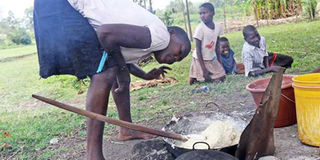Premium
Rampant use of wood fuel claims more lives than road accidents, warns CS

A resident of Rodi Kopany, Homa Bay County, cooks using the three-stone cooking fire. Wood fuel exposes people to health risks. PHOTO | FILE | NATION MEDIA GROUP
What you need to know:
- Given that many households also use multiple solutions and might have other cookers, about 64.7 per cent of households use wood as their primary cooking fuel.
- Over the last two decades (1999-2018), the number of households using LPG has increased about six-fold from 600,000 to 3.7 million.
The traditional three-stone cook stove remains the most commonly used cooking technology in Kenya with 58.1 per cent of the population using it, according to the Kenya Cooking Sector Report, and the Cabinet Secretary (CS) in charge of energy has asserted that the death toll from fuelwood use is higher than that of road accidents.
An overview of the supply and demand of household cooking solutions, commissioned by the Clean Cooking Association of Kenya in collaboration with the Energy ministry, which was released last Tuesday, shows that more than half of Kenya’s homes use the traditional cook stove.
There has only been an 18 per cent drop in households using this method in 20 years. In 1999, 76 per cent of households relied entirely on this technology, the report reveals.
Researchers conducting surveys on Kenya’s cooking energy mix found that although the proportion of household users has dropped, the aggregate number has increased from 4.7 million to about 7.3 million households, based on overall population growth.
OLD IS GOLD
Seventy per cent of households in Kenya were found to be using some type of wood stove as either their primary or secondary cook stove. Most of these, at 92 per cent, are in rural areas.
Tellingly, when the respondents were asked by the researchers to select their most preferred stove, 28.6 per cent of rural residents said that given other options they would still take the traditional cooker.
“(This is in spite of) it having been (taunted) as an inferior technology associated with very low efficiency rates and lots of health risks,” observed the report.
However, given that many households also use multiple solutions and might have other cookers, about 64.7 per cent of households use wood as their primary cooking fuel.
HEALTH IMPACTS
This is in spite of the known negative health and environmental impacts of burning wood due to high emissions, and health complications such as respiratory and heart diseases, lung cancer, and eye irritations.
“The new data that has emerged from the Clean Cooking Study commissioned by my ministry and the Clean Cooking Association of Kenya indicates that 92 per cent of the rural populations still rely on polluting solid fuels as their primary source of fuel,” noted Energy Cabinet Secretary Charles Keter. Africa makes a majority of the over 60 per cent people around the world still heavily relying on solid biomass for fuel, the CS added.
“Further, the study findings confirm that wood fuel (charcoal and firewood) is the most commonly used primary cooking fuel, with 75 per cent of Kenyan households using it.
“This means that there is great exposure to harmful pollutants that are one of the largest health risk factors for mortality in Kenya, resulting to (sic) about 21,560 deaths annually. This is more than the average number of deaths caused by road accidents,” Mr Keter said.
EXPENDITURE
The study was an important baseline to guide the development of policies in the sector, he added.
The Kenya Cooking Sector Study, an assessment of cooking solutions at the household level, and carried out between October 1 and November 14, 2018, noted: “Energy researchers have over time observed that when new cooking solutions are introduced in a household, existing options are rarely displaced.
“Rather, it is more common to see new options incorporated into the mix of cooking solutions.”
The study also found that in spite of the ban on charcoal, its average use among households that rely on it is 395kg per year.
Figures on weekly charcoal expenditure collected from respondents show the annual market value of charcoal consumed by the residential sector alone is Sh68 billion.
This is twice the amount spent on LPG and almost 40 per cent more than what all domestic customers paid to Kenya Power in 2018 for their electricity consumption according to Kenya Power’s 2018 annual report.
LPG GAS
On a positive note, over the last two decades (1999-2018), the number of households using LPG gas has increased about six times from 600,000 to 3.7 million.
This is especially telling for Kenya whose government seeks to have 100 per cent of the population having access to modern cooking solutions by 2030.
Mr Keter said that under the Paris Agreement, Kenya committed to reduce its greenhouse emissions by 30 per cent where clean cooking is expected to contribute some 14 per cent of this target.
Kenya has formulated a progressive energy policy and enacted a robust Energy Act 2019, geared towards the provision of affordable and sustainable energy services, including clean cooking.





